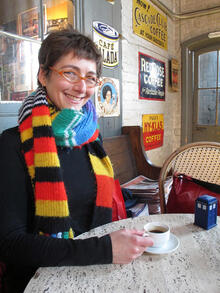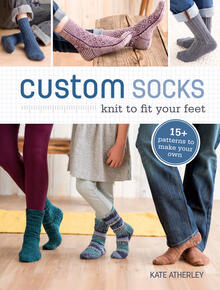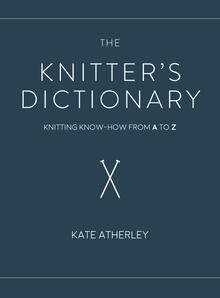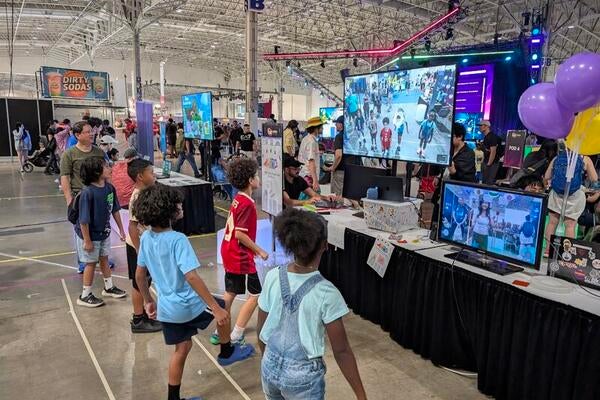
When a hobby becomes a career
Kate Atherley (BMath '92) explores her unlikely career journey from software to knitting.

Kate Atherley (BMath '92) explores her unlikely career journey from software to knitting.
By Kate Atherley (BMath '92) AlumnusIf I’m being honest, I’m not really sure what I intended my career path to be.
When I was in high school, I was an avid reader and writer, and really enjoyed language and literature classes. My decision to study mathematics was a hasty one, and a surprise to everyone – including me.
 I enjoyed most of my classes in my first year at Waterloo, but found the most satisfaction in those that focused on logic and rules. Applied mathematics was just a little bit too messy for my tastes, and computer science too practical. I absolutely loved the tidiness of Pure Mathematics, the rigour and clarity and elegance. When asked about my degree, I often joke that I spent four years doing logic puzzles.
I enjoyed most of my classes in my first year at Waterloo, but found the most satisfaction in those that focused on logic and rules. Applied mathematics was just a little bit too messy for my tastes, and computer science too practical. I absolutely loved the tidiness of Pure Mathematics, the rigour and clarity and elegance. When asked about my degree, I often joke that I spent four years doing logic puzzles.
But if you asked me what I intended to do with that degree… I had no ideas, no answer. After the third year, I travelled with some fellow students, visiting possible graduate schools. It became clear to me that although I enjoyed the discipline, mathematics didn’t run through my veins in the way it did my friends’. I took my math degree and headed out into the working world. I’d gone through the co-op program, and had experience working in software companies, so I fell into the most obvious and perfect job: working at Waterloo Maple, a company that developed a mathematical programming language.
Because of my writing and communication skills, I divided my time between user support, training and technical writing. I moved around a fair bit in the software industry, changing jobs when I got bored or frustrated. In the 1990s, small software companies were forever changing hands, merging, transmogrifying, and I floated around. Although I liked the work, I always struggled with the culture at these types of companies: I was too ‘arty’ for development teams, too technical for marketing (and certainly didn’t have the right skills for sales). My best jobs were those where I sat between the technical and the non-technical types, as an interpreter: user support, training, documentation.
I’d been a knitter most of my life. For many years, it was an on-and-off activity, based on whether I had any spare time. Very little knitting got done while I worked on my degree, but as soon as I graduated I picked it up again.
 For a few years, I knitted privately: at home, on my commutes to work, at the odd baseball game. Until that fateful day that they talk about in the movies – the day your life changes. I had left my knitting on my desk at work, and one of my colleagues noticed it, and remarked in passing that his partner was planning to open a yarn shop. She and I had coffee, before I even knew I felt this way, I found myself saying to her that I would like to try teaching.
For a few years, I knitted privately: at home, on my commutes to work, at the odd baseball game. Until that fateful day that they talk about in the movies – the day your life changes. I had left my knitting on my desk at work, and one of my colleagues noticed it, and remarked in passing that his partner was planning to open a yarn shop. She and I had coffee, before I even knew I felt this way, I found myself saying to her that I would like to try teaching.
Twenty years later, I make my living through knitting. I travel internationally to teach, I write and edit books. And I’m doing exactly the same thing I was doing in software: I’m an interpreter between the technical and non-technical types. After all, that’s what teaching is. My books take a slightly unusual approach, in that it’s not just about standardized step-by-step patterns; I teach knitters how to adapt and adjust and customize their knitting so that it fits them precisely. There’s a huge amount of mathematics and number crunching in that, of course.
 I get the most satisfaction in the technical writing and editing. I’ve become very well known for my skill in helping other designers write patterns and instructions. I work with designers and publishers around the world, and I wrote the only book on the market about how to write knitting patterns. I find myself thinking about usability in exactly the same way I did when writing product specifications for the developers. I try to write clear instructions for knitters of all skill levels and information processing styles, in exactly the same way I did when I was writing software documentation. Although it’s not as immediately obvious, my mathematics training is just as important here: even when there’s no numbers, knitting patterns need rigour and rules and precision.
I get the most satisfaction in the technical writing and editing. I’ve become very well known for my skill in helping other designers write patterns and instructions. I work with designers and publishers around the world, and I wrote the only book on the market about how to write knitting patterns. I find myself thinking about usability in exactly the same way I did when writing product specifications for the developers. I try to write clear instructions for knitters of all skill levels and information processing styles, in exactly the same way I did when I was writing software documentation. Although it’s not as immediately obvious, my mathematics training is just as important here: even when there’s no numbers, knitting patterns need rigour and rules and precision.
I have built myself a career where my unusual mix of arty and logical is valued, and where my communication skills are applied to something that brings pleasure and creative satisfaction. I perhaps don’t knit quite as much as I would have expected, making a living in the knitting world – but if that’s my only complaint, it’s not a bad one.
Kate Atherley is a globally recognized knitting instructor and seasoned designer. She has published seven books for knitters, and she’s the technical editor of knitty.com. Follow her on Twitter and Instagram to learn more.

Read more
Here are the people and events behind some of this year’s most compelling Waterloo stories

Read more
Waterloo-based startup is supporting children with disabilities by transforming physiotherapy exercises into motion-based games

Read more
From co-op to startup: Waterloo students develop an AI platform that uses real-time data for wildfire prediction and early prevention
The University of Waterloo acknowledges that much of our work takes place on the traditional territory of the Neutral, Anishinaabeg, and Haudenosaunee peoples. Our main campus is situated on the Haldimand Tract, the land granted to the Six Nations that includes six miles on each side of the Grand River. Our active work toward reconciliation takes place across our campuses through research, learning, teaching, and community building, and is co-ordinated within the Office of Indigenous Relations.